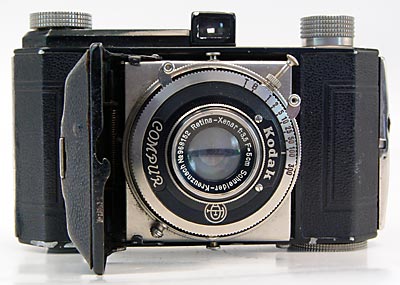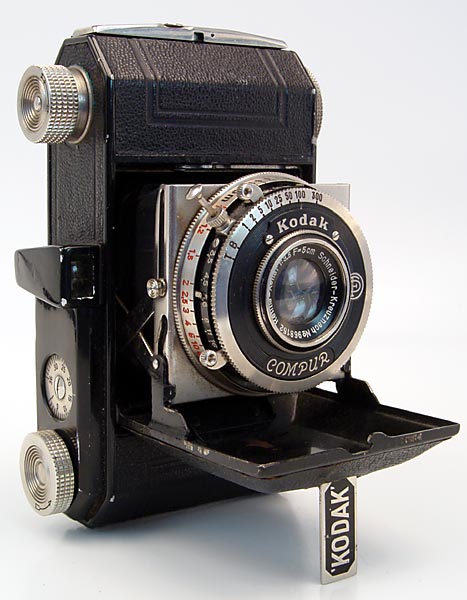Kodak Retina I [1934]Retina 1: the German Kodak
Flash back to the early 80's; I was teenager growing up in the northwest of England. I had a interest in photography and cameras but little disposable income. Still, I wasn't going to let that stop me. I prowled the junk stalls at the local open air market and picked up the bargains I could afford; mainly Kodak folders and box cameras. I'd clean them up and then carefully arrange them on the bookshelves in my bedroom. In the mid-80's I went off to university and my junk camera collection got packed up in boxes and was stashed in my parents attic. Since then I've moved to the US and my parents have moved house a couple of times. My junk cameras may still be in the attic or they may have been sent to a rummage sale along with my action men and legos long ago. Despite having to pack up my childhood junk camera collection I did keep a couple of folders out that interested me and they have traveled with me all these years. When I move somewhere new they have always come with me to stand guard on my bookshelves and collect dust. While browsing the web recently I stumbled upon a camera that looked familiar; the Kodak Retina I. Wasn't that the camera I kept in the guest bedroom? I'd always kept it around because it was a cute little folder; I thought it had little value or usefulness but here I was reading about some collectors who specialized in collecting and using Retinas. I did a little rooting around and I found out what I had was a Retina I (type 119 if you need to know specifics) dating from somewhere around 1934-37. Here was a camera from the dawn of the history of the 35mm cassette, a time more usually associated with the Leicas but the Retina I was the camera Kodak themselves sold with their release of the 135mm film cassette. What's more, this wasn't your typical cheaply made Kodak folder; this was a German Kodak! 
Then, as now, Kodak was more interested in selling consumables than cameras. Kodak wasn't convinced about the viability of the 35mm format and didn't want to invest the time itself developing the 35mm camera. Therefore, Kodak acquired Nagel Camerawerk in Germany, who were already producing the Retina and were a respected manufacture in their own right. I retrieved my neglected Retina and started to look at it with a new found respect. Examining the Retina I you immediately get a feeling of quality you don't normally get from a typical Kodak folder. There's a scale focusing, relatively fast for its day, f3.5 lens. Adjustable shutter speeds up to 1/300th of a second! This camera was made in the days before leatherette had been invented; if it looks like leather, it's leather on this camera. Being manufactured 70 years ago and having spent the best part of five decades idle you would have thought this camera's mechanics would be gummed up and in need of serious cleaning, after all, it seems that you only have to leave a Canonette unused for a couple of months for the shutter to become sticky and inoperative. However, after finding my way around the Retina and cocking and tripping its shutter a few it looked to my untrained eye accurate enough to trust a test roll of 35mm negative film to. That was how I found myself out and about with the oldest 'user' camera in my collection. I want to say that there is a feeling of nostalgia about using this camera but as it came into being 30+ years before I did that would not be an accurate statement. You definitely get a feeling of what it must have been like to be a photography enthusiast in days long gone. In that way it is something like using a ghost. You can't help but wonder about the people who have used that camera before you; the previous owner whose steady use of the manual film counter interlock controls wore through the black enamel paint. What did he take pictures of with this relic? What 'new' camera did he replace the Retina with? Did he have as much trouble as I do squinting through that tiny viewfinder? The workflow for shooting this camera certainly slows you down and it makes you think about what you are doing before committing an image to film. First you must release the film winding mechanism before winding on to the next film frame. It is best to guesstimate and set the focal distance from the camera to the subject before setting the aperture as the focusing mechanism has a tendency to change the aperture too. With your aperture and shutter speeds set (no built in meter to help you with that I'm afraid) you are now ready to cock the shutter. As mentioned previously, the viewfinder is very squinty but you are now ready to compose and expose the shot before repeating the process all over again. So how does the oldest user in my collection stack up to modern equivalents with its uncoated optics? ... In 70 years time I wonder if any of today's digital wunderkind cameras will even turn on never mind be able to take contemporary pictures. Will anyone collect, restore and use consumer digicams from the turn of the millennium? It seems unlikely but then here is a German Kodak that is still in occasional use today so I know better than to say 'never'. Comments
A very interesting read - particularly since I recently took receipt of a No. 1 Autographic Kodak Junior Model A circa 1914. The viewfinder might as well not be there but everything else about the camerascreams photography. As you rightly state it does make you slow down - which is no bad thing. Posted by: Smallest Photo at August 5, 2005 4:17 PMhi, i just this second bought a kodak retina 1a, and it seems like a really sweet camera. i appreciated your article, and will keep you informed. hope i can figure out the little nuances without much difficulty. :-) robin Posted by: robin at August 5, 2006 3:48 PMhow much cost that camera,can I buy at the store?? Posted by: Bogie at April 14, 2009 10:29 AMPost a comment
|
|
All content © 2003-2011 the other Martin Taylor.